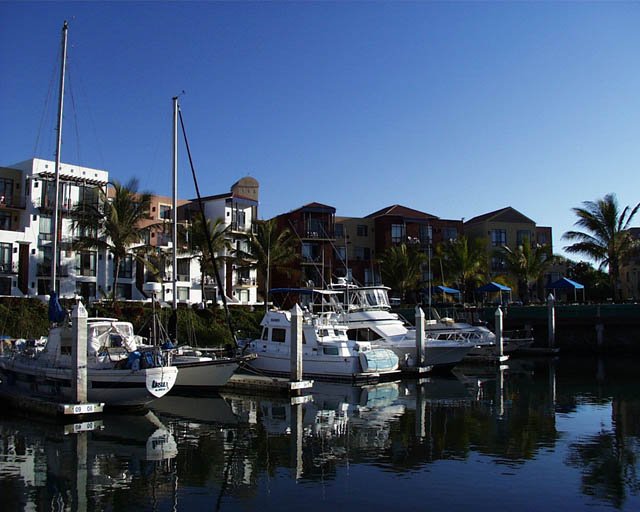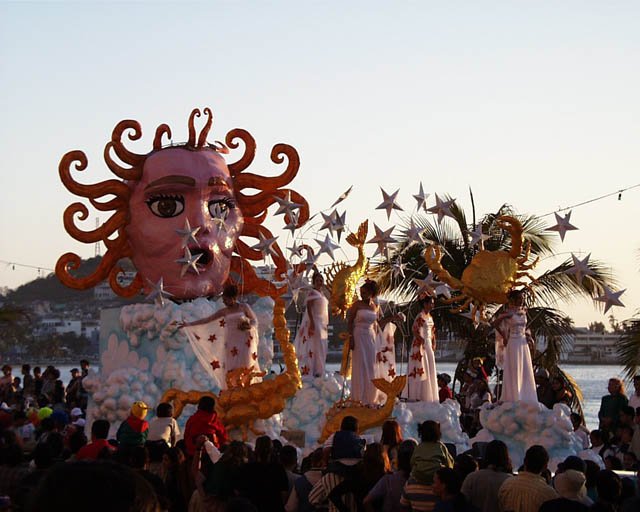Log #25
Thursday March 2nd, 2000—Flying into Mazatlan
AeroMexico
flew me into Mazatlan from San Diego with a two-hour layover and in Hermosillo.
Flight 175 from Hermosillo arrived in Mazatlan after dark. Clearing immigration
in Mexico was straightforward, but clearing through Mexican customs was
more interesting.
After collecting
my duffle bags, I approached Mexican customs in the airport. There I was
greeted with what appeared to be a large stoplight with two lights: one
red; one green. Each person clearing through customs must approach the
stoplight and then press a button. If the light turns green, you’re free
to go; no questions asked. If the light turns red, you can plan on staying
a while because all of your bags get searched. The first time I passed
through one of these, I had no idea what was happening, other than that
the light turned green and I got waved through. I thought perhaps it had
something to do with a Mexican lottery, and that a green light entitled
me to millions of pesos. Not the case.
This time,
the stoplight turned green, so I breathed a sigh of relief. Not that I
carried any contraband. But I did have a few small replacement parts for
the boat, including three quarts of Epifane varnish. Flying down from
San Diego, I had visions of the Epifane cans exploding in the luggage
compartment due to pressure changes. I had visions of three successive
pops, followed by an emergency landing, followed by the Federales escorting
me off of the plane to a Mexican prison where no one would ever hear from
me again. Fortunately, the lids on the three quarts held tight, sparing
me from both Federales and prison.
When bringing
in spare parts, I have learned to remove all of the original packaging
and pack these items into the side compartments of my duffels. This lesson
came the hard way. Early in January I returned to Mexico with a replacement
Autohelm anemometer system, complete with 100 feet of cable in the original
packaging—a large box that filled the entire center compartment of my
largest duffle. That time, as I held my breath and pressed the button,
red light blasted me in the face. Despite copies of my ship’s registry,
accompanied with explanations that these replacement parts weren’t available
in Mexico, I was led to a small room where … discussions were had. Plying
them with “no entiendo” (I don’t understand) and expressions of innocence,
they eventually let me go. In retrospect I think this had more to do with
the late hour, as well as the fact that I had no receipts for the aforementioned
contraband—I mean replacement parts. It’s difficult to assess a fine when
you can’t document the value. This is not a recommendation on how to do
this. (Or is it?)
As I mentioned,
however, this time I was ‘green-lighted,’ and passed through to a waiting
cab. As the taxi sped me through the darkness toward Mazatlan, I looked
forward to seeing Dan and Debi on Andanté. Andanté was moored at Marina
El Cid. Marketed as “mega resort,” Marina El Cid includes a small marina
surrounded by beautiful condos and multiple swimming pools with caves
and waterfalls.
 |
|
|
Marina
El Cid (link)
|
|
I found Andanté
tied off to the main dock swinging gently in the currents. After catching
up on our separate adventures over the previous six weeks, and a brief
show-and-tell about replacement parts, I dove into my aft berth to charge
my batteries for the oncoming weekend. After all, carnival weekend approached.
Friday
March 3rd, 2000—Festival of Flowers
I
awakened to sunshine, warm temperatures, and one of Dan’s famous banana
pancake breakfasts, complete with real maple syrup. Sadly, the maple syrup
was starting to run low. I will bemoan the day we retire this particular
syrup jug, because it has accompanied me from Alaska to California to
Mexico. That's faithful companionship.
Breakfast
and dishes completed, we walked the tienda-lined streets of Mazatlan,
and made a stop at a favorite street-side vendor for a bag of fresh sugarcoated,
deep-fried pecans. If you’ve never sampled this particular confection,
you have to try it at your earliest opportunity: Crunchy, bite-sized bits,
sweetened with caramelized sugar, and a roasted pecan inside. It’s a taste-fiesta.
After strolling
the streets we grabbed an open-air taxi to the local shopping mall. Mazatlan’s
open air taxies fill the main drag and spew gasoline fumes that mix with
the diesel fumes from the busses. It reminds me of Los Angeles. Looking
back to Mazatlan from the water, LA-brown smog hovers over the city.
Adjacent
to the shopping mall we found a Sam’s Club. Similar to Costco, Sam’s is
descended from Sam Walton’s Walmart stores. Plying them with her negotiating
skills, Debi secured a day pass for us, enabling us to tour the store
and inventory available products. Like Costco, Sam’s Club offers a plethora
of name-brand goods. Because the annual fee is only $25.00, and because
Sam’s was clearly the best provisioning opportunity in town, and because
more Sam’s Clubs can be found down the Mexican coast, I joined.
We taxied
back to Marina El Cid, only to discover that Dan accidentally left his
camera in the vehicle. Later we stopped by the taxi company to find out
if the camera had been turned in. No luck. The manager, however, presented
us with three four-inch thick books consisting of photographs of each
driver. Across the three books there must have been a thousand or more
photos. Assuming we could remember what the driver looked like, the manager
promised to follow-up. After Dan and Debi flipped through a few pages,
we realized that this was a classic exercise in futility.
Friday night
the Festival of Flowers, a special carnival event, occurred at the local
baseball stadium. Before the event we had time for a sidewalk table dinner
at Mr. Acs. To those of us educated in English, this looks and perhaps
sounds like “Mr. Acks.” But the artwork of the Ace of spades, clubs, diamonds,
and hearts, led us to understand that a more appropriate English spelling
would have been Mr. Aces.
The main
event at the Festival of Flowers turned out to be an operatic oratorio
titled Carmina Burana by Carl Orff. According to onboard references,
Carmina Burana includes the following lyrics from an anonymous
quote, referring to Eleanor of Aquitaine (whoever she is):
Were
the world all mine
From the sea to the Rhine
I’d give it all
If so be the Queen of England
Lay in my arms.
We think
all of these lyrics were performed in Latin. In other words, Carmina
Burana was heavy, dense, complex, and—OK let’s be honest—unintelligible.
Latin speakers and musicologists may, of course, disagree. Contrary opinions
welcome.
That said,
we were impressed by the caliber of talent assembled for this work, which
certainly tapped the national Mexican arts community. It was a serious
undertaking, conscientiously executed. A particularly impressive male
countertenor sang a section of the work entirely in falsetto, and at an
impressive volume. One could only stare in amazement, and wonder if what
they were paying him was worth this effort.
Orff’s spectacle
completed, stage hands swept venue clean for the next event: a very large
regional Mexican brass band—perhaps with 40 or 50 musicians. The band
played in typical mariachi style—very loudly, with only a distance trace
of melody—intelligible only those trained in discriminating such things.
We were not. The performance sounded like two elephants competing for
the harem during a train crash. Many of the evening’s dignitaries flanked
the band, and clapped and danced them on. And on. And on. Clearly, the
locals preferred these guys to Orff—may he rest in peace, which was probably
difficult for him that evening, had he been watching on. And on. And on.
We left some time well into the first set.
Saturday
March 4th, 2000—Street Party
After a rigorous
Friday evening, and in anticipation of another late night on Saturday,
we took the most appropriate action feasible Saturday morning and slept
in. After gaining consciousness some time around noon, we caught a taxi
to old town. First, we visited NidArt—a gallery specializing in leather
masks and sculptures. (Libertad 45 Centro, Historico Mazatlan. Tel-fax:
(69) 81 00 02. E-mail: nidart@mazatlan.com.mx) This was my third visit
to NidArt, and I was surprised to discover only three leather masks hanging
on their display wall. Normally decorated with twenty or more masks, the
carnival hordes apparently vacuumed the gallery clean. Good news for NidArt,
although a disappointment for us.
Between NidArt
and the main square we strolled through the historical area of Mazatlan,
including an old theater built in the 1860s and recently restored in 1993.
We toured
the indoor market with ample offerings of clothes, shoes, guitars, vegetables,
fish, and meat kiosks. Back on Andanté we succumbed to a siesta, required
in preparation for more carnival festivities that evening.
The carnival
schedule indicated that the mock sea battle (e.g. fireworks) would start
at 22:30. Admission to the street festival site cost all of 10 pesos,
but required segregated entry—men in one line and women in another. This
enabled the authorities to more quickly search the hombres, who were forcefully
invited to lean spread-eagle against an adjacent rock wall for a thorough
going-over. Dan and I, being Anglo amigos, were waved through. Good thing,
because Dan had forgotten that he carried a four inch rigging knife in
his travel pouch. The knife could have easily resulted in a quick trip
to the hoosegow.
(You may
know that hoosegow is slang for jail. Aha, but did you know that hoosegow
comes from the Mexican Spanish jusgado, which is from the Spanish juzgado,
which means courtroom? But wait, there’s more: juzgado is from the past
participle of juzgar, to judge, which is from the Latin judicare. Inquiring
minds want to know.)
Safely inside
the weapons-safe street fair, and smugly confident that we were the only
ones ready for a knife fight, we walked the waterfront promenade until
we happened upon a restaurant overlooking the fireworks. Small problem
in that the restaurant appeared closed, or at least engaged in catering
to a private party. A knock on the door, however, gained us entry. From
the corner window we enjoyed a casual almost private dinner and watched
the fireworks explode in the street overhead. Amazing how close you can
get to fireworks in Mexico. Watching the sparks and cinders fall directly
underneath our window, we felt relieved to have some shelter from the
falling embers.
 |
|
|
Mazatlan
Carnival Fireworks
|
|
Post-fireworks
the street party took off as we worked our way, on foot, back towards
home. Taking their cue from the fireworks, the streets exploded with people
who were just getting going. Youthful, militant, conga lines—led by brawny
hombres with an attitude—found sport in running through the congested
crowds. At first these phalanxes seemed annoying—particularly if you happened
to be standing in their path. But we discovered that they provided quick
transit through the crowds. By attaching to the tail end of a passing
conga bullet train, you could make much more considerable and rapid progress
towards your destination. After successfully catching several passing
conga lines, we soon found ourselves lonely and stranded. (Well, at least
stranded.) Not to be daunted, Debi seized the lead and formed our own
line, which took on a life of its own, expanding and contracting as the
locals found it useful, or not. Positioned at the end of the line, I felt
myself being squeezed in … interesting places, and turned to discover
a laughing young Mexican woman behind me who found a more amusing use
for her hands than simply holding on.
Sunday March
5th, 2000—Floats, Costumes, and Tractors
We awakened
just as the noon sun broke overhead. Debi prepared fresh guacamole for
lunch. Then we headed off to the bus station to check on our tickets to
El Fuerte, our jumping off point for Copper Canyon on Monday.
After our
stop at the bus station, we made our way back the waterfront area and
found a hotel that had built a viewing platform overlooking the parade
route. We inquired about seats, only to discover that they were sold out.
I tried to persuade the woman in charge of seating with a $20 US bill,
only to receive the same answer. We asked if we could stand in the area,
and they said ‘OK.’ Several minutes passed, and miraculously, the seat
manager reappeared and escorted us to the requested number of seats.
I ventured
onto the street in search of something that looked both edible and safe.
The best option appeared as a slice of pizza with chorizo (hot Mexican
sausage) and jalapéno peppers—not for the timid, which I was. But I tried
it anyway. After the pizza, I needed something to quench the fire, and
found at a street side vendor selling freshly cut jicama slices served
with a sprinkling of chili powder and lime juice It looked less than appetizing,
but tasted wonderful.
The quality
of parade floats ranged from simple and unsophisticated to artistic and
elegant. Despite the range of entries, human anatomy powered virtually
all of the floats’ moving parts, such as turning heads on bodies, rotating
planets, and flying birds. On one float mother earth spun so fast that,
had it been to scale, everything on the planet would have certainly flown
off into outer space.
 |
|
Carnival
Float
|
No matter
what size or quality, another inexpensive and locally abundant power supply
energized every single float: Tractors. One of the tractors shot bright
orange sparks out of the exhaust pipe six feet into the night sky, showering
bystanders with hot ash.
When the
parade ended we again took to the streets and walked north along the main
waterfront towards the marina several miles distant. It seemed as if twice
as many people roamed the streets on parade night, vs. the previous evening.
This time, however, there were no conga lines to help transport us through
the crowds.
A local
television station had constructed an elevated broadcast platform in the
middle of the street. Although the parade had ended, a newscast team still
broadcasted live atop their private oasis surrounded by a sea of enthralled
bodies. We approached the bottleneck with the idea of passing through.
Once committed, however, we realized that the presence of the cameras
attracted a crush of people that was not easily passable. Immediately
below the platform we had little control of speed or direction, and focused
primarily on staying upright to avoid being stomped on.
Many of the
locals demonstrated savvy parade night experience: They had staked out
small areas along the parade route with lawn chairs. As the throngs struggled
into each other, families camped out in the meridian calmly watched everyone
pass and waited until passage was more manageable. Despite our long distance
and inexperience with the crowds, we eventually made it back to our marina,
which seemed overly quiet in its post-carnival solitude.
Up
Next
Log
#26—Copper Canyon
|

